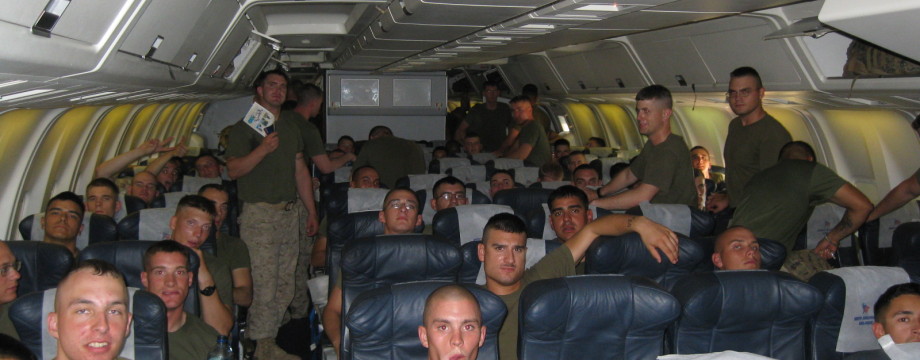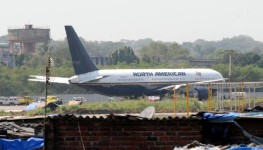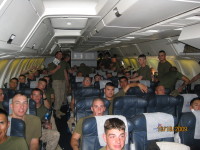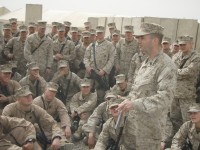A chartered aircraft carrying Marines from Headquarters & Service Company and battalion augments from III Marine Expeditionary Force was forced to land in Mumbai, India, due to bureaucratic issues. The plane was held on the runway for over 24 hours. — Source: Michael Burke, Justin Palmer
Contents
News
U.S. plane with Marines takes off
Chhatrapati Shivaji International Airport (BOM)
A chartered aircraft carrying Marines from Headquarters & Service Company and battalion augments from III Marine Expeditionary Force was forced to land in Mumbai, India, due to bureaucratic issues. The plane was held on the runway for over 24 hours.
A Bangkok-bound chartered U.S. plane carrying U.S. Marines among 205 passengers, which was ordered by authorities to land at Mumbai airport for flying over Indian airspace without getting mandatory military clearance, took off on Monday after being grounded for over 33 hours.
The aircraft was ordered to land in Mumbai on Sunday (Oct. 18) after it entered Indian airspace without necessary permission.
“The necessary regulatory permissions have been worked out,” a Mumbai Air Traffic Control (ATC) official told PTI here.
The issue relating to payment of navigational charges has also been sorted out, the official said.
The ATC had earlier rejected the payment for navigational charges by credit card.
The U.S. military-chartered Boeing 767 plane, belonging to North American Airlines, was on way from Fujiriah in the U.A.E to Utapao in Bangkok. It landed at Mumbai airport at 0752 hours on Sunday and was parked at a remote bay.
Confusion over call sign
The aircraft was made to land in Mumbai while flying over Indian airspace as there was some confusion about its call sign.
The transport aircraft had “civilian clearance from Directorate General of Civil Aviation (DGCA) to fly over Indian airspace,” Indian Air Force (IAF) spokesperson Wing Commander T. K. Singha had said.
“However, it was carrying military personnel, for which the aircraft should have obtained Air Operation Routing clearance (AOR), needed for a military aircraft,” he said.
Foreign military aircraft have to obtain two sets of clearances before flying over India.
Once the aircraft entered Indian air space, the IAF ordered it through radio communication to land in Mumbai, to which it complied with, Mr. Singha said.
The aircraft did not take off yesterday as the pilot had crossed his flying duty hours.
The U.S. embassy said, “We were pleased that we were able to resolve the procedural matter in an expeditious fashion and appreciate the assistance and cooperation of the Indian authorities“.
Speaking on the sidelines of the Indo-U.S. exercise in Agra, U.S. air attache to India, Colonel Steward Kowal, told reporters that the aircraft was made to land in Mumbai due to “misunderstanding with call sign“.
Fourth foreign aircraft since June
“We view it as an example of the strength of Indo-U.S. relations. We thank India for resolving the issue quickly,” he said.
This is the fourth incident of a foreign aircraft violating rules relating to obtaining of clearance to fly over Indian airspace or other disputes since June this year.
On June 20, a Ukrainian-made military cargo aircraft AN-124, operated by a Russian private airline Volga-Dnepr and chartered by U.S. defence forces for flying out military equipment from its base in Diego Garcia island to Kandahar in Afghanistan, was caught in a similar situation.
The IAF had ordered it to land in Mumbai as the aircraft did not have AOR clearance. It was detained for 24 hours and was asked to fly out after it obtained necessary clearance.
On Aug. 27, the IAF radar in Punjab had picked up an Air France aircraft (A-343) flying from Paris to Bangkok, as it did not have a proper identity.
The IAF scrambled MIG-29 fighter jets to intercept it and it was asked to identify whether it was a friend or a foe.
In the first week of September, a China-bound cargo plane of the United Arab Emirates (U.A.E) Air Force was detained and its 10 crew members, including the pilot, were questioned after customs officials found arms and ammunition on board the aircraft. The plane had made a scheduled transit landing at the Netaji Subhash Chandra Bose airport, Kolkata.
The crew members had not informed in the routine declaration submitted to authorities that arms and ammunition were in the plane.
Copyright © The Hindu 2009
Photographs
- Source: The Hindu
- Courtesy: Michael Burke
Testimonials
First Sergeant Michael Burke
Company First Sergeant, H&S Company
Flight of Tears Part 2: The Mumbai Conspiracy
Flight of Tears Part III: Buh-Bye Mumbai
Lance Corporal Justin Palmer
Battalion S-2
I mostly slept for the first part of the flight, passing out after we left Al-Asad and briefly waking up when we landed in Dubai. But I remember waking up at dawn because of some sort of commotion and looking out the window and having no idea where we were. I asked my seat-mate Ryan Guedry what was going on, and he said we were in a holding pattern off of India and were being forced to land. I vaguely remember some rumor about if we didn’t land they were going to shoot us down. I was a bit concerned: India is kind of a ‘frenemy’ country and I was one of several “couriers” on the flight, responsible for bringing back secret intelligence materials from Iraq to our office in Hawaii. Memories of the U.S. spy plane forced to land in China in 2001 floated through my mind, and I considered whether we would have to either destroy out materials and hard-drives, or (in one of my less bright ideas) throw them out of the plane.
We eventually landed, and I thought we would be airborne again in a few hours. Nope. Apparently the holiday of Diwali was in progress, and the airport staff who could have sorted out the mess were all on vacation. So we waited… and waited… and waited. Some of the Marines were able to get Internet and pulled up massively inaccurate news stories about Marine commandos on vacation. I was extremely worried: our flight path took us extremely close to Iran, Pakistan, and Myanmar, none of which particularly liked us, and all of which now knew exactly where we were. This was also about a year after terrorists attacked the Taj Mahal Hotel, so there was obviously some sort of enemy presence in the city… and they also knew we were there.
Eventually someone from the U.S. consulate showed up and said we wouldn’t be going anywhere anytime soon, but later were able to get most of us into a hotel. I was chosen as part of the remain-behind security detail to watch our weapons and gear.
As the rest of the battalion de-planed to go to their hotel, one of our senior leaders pulled the security detail aside and solemnly said, “This plane is sovereign American territory. You are to prevent anyone from boarding it using any means necessary, including deadly force.” I asked, “With what?” While we had our rifles, before leaving Iraq we had conduced a thorough ammo search, and had also been required by the airline to stow our magazines and even the bolts for our rifles in our sea bags. With the mags we could have faked Condition One weapons, but now it would be pretty obvious there was nothing in them. He glared at me, muttered, “Use your MCMAP skills,” and left with everyone else. I heard later that the hotel was nice, but the trip there past Mumbai’s slums was not. Some of the Marines were apparently unnerved at the sight of a local woman defecating on the side of the road.
The rest of our stay was relatively uneventful: the consulate ordered Indian take-out for those of us on the plane, which was delicious. I was able to plug my laptop in to one of the plane’s outlets and watch movies all night, plus we were able to stretch our legs and sleep. The next day was basically a repeat of the first: long, hot, and sweaty, with multiple delays, although when we finally took-off the whole plane cheered.





